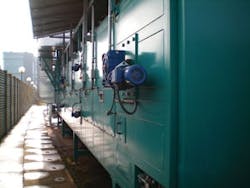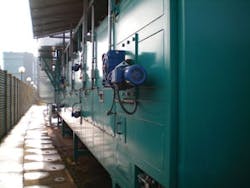EPA Pilots Effort to Reduce Stormwater Pollution
EPA will require new measures to control stormwater pollution in the Charles River watershed in Massachusetts. Under a pilot program that could be expanded to the entire watershed and perhaps the nation, large industrial, commercial and multi-family residential facilities in three communities in the Upper Charles River Watershed will be required to reduce polluted runoff from their properties. This initiative is part of a continuing, multi-faceted effort to restore the Charles to environmental health.
The EPA action will apply to properties with two or more acres of impervious area (parking lots, roofs, roadways, etc.) in the Towns of Milford, Franklin, and Bellingham. These large property owners with two or more acres of impervious surfaces will be required to obtain an EPA Clean Water permit, and to take steps to reduce pollutants in stormwater.
Large impervious areas are one of the last major unregulated sources of water pollution, and a chief culprit in dramatic algae blooms – including toxic cyanobacteria – that have plagued the Charles in recent years. Extensive impervious cover also aggravates the severity of flooding because those areas diminish the amount of land that can naturally soak in and filter rainwater.
The federal Clean Water Act mandates that storm water sources that degrade water quality below minimum standards be managed to reduce the harm they cause. Numerous studies have demonstrated a direct link between pollution in storm water and large impervious surfaces such as those coming under regulation with this permit.
Over the past dozen years, Federal, state, and local governments have invested hundreds of millions of dollars to clean up the Charles River, taking action to nearly eliminate sewer overflows, to improve wastewater treatment plants and to clean up stormwater.
"Today EPA is asking everyone to do their fair share to protect our most precious resource – a clean environment that supports healthy communities and a robust economy," said Curt Spalding, regional administrator of EPA's New England office. "This effort will spur creative thinking to develop appropriate green infrastructure to help capture stormwater before it is channeled into our rivers, lakes and streams. EPA will provide maximum flexibility and a reasonable time-frame to ensure that together we all will protect the Charles."
Currently, municipalities bear the burden for managing all of the stormwater that flows from public and private properties through their storm drain systems. The proposed pilot program will shift some of that burden to the private properties such as mall parking lots and commercial and industrial office parks that shed substantial volumes of contaminated stormwater through municipal pipes. Under existing regulations, virtually all of these facilities are not required to control stormwater, even as municipal governments face tightened stormwater requirements.
Two 90-inch MagMaster electromagnetic flowmeters from ABB will measure the effluent from the new $45 million pump station at the Southerly Wastewater Treatment Plant in Columbus, OH. The two meters each have the capacity to measure 225 million gallons daily. The piping configuration provides for adding a third 90-inch magmeter in the future.
The permit is designed to encourage private property owners and municipalities to work together, to produce a comprehensive approach to storm water management. Under the EPA program, property owners can choose to control their own stormwater to specified standards, or can work with their town government on a community-wide approach. Facilities can choose from a simple menu of stormwater controls, and receive specified credits to meet their reduction requirement. Analyses conducted by EPA and the Mass. Department of Environmental Protection indicate that municipal-wide programs will produce greater benefits at lower costs.
"This pilot program will provide valuable information about effective strategies to manage stormwater from commercial, industrial and other private properties in these three communities," said Laurie Burt, Commissioner of the Massachusetts Department of Environmental Protection. "The information gathered through this pilot is important and will help demonstrate how businesses, working with local communities, can best address stormwater-related water quality challenges. At the same time, the pilot will provide valuable information that can help other Charles Watershed communities in their efforts to meet water quality standards."
The importance of controlling stormwater has been underscored with the recent intense rains and flooding experienced in New England. Stormwater controls such as those encouraged by this program will help reduce the severity of flooding. Capturing stormwater for infiltration back into the earth helps ensure a clean and safe water supply, replenishes depleted groundwater, and filters contaminants out of water before it enters lakes, ponds, rivers or streams. Under the EPA program, permittees will be required to infiltrate storm water into the ground where feasible, thus restoring underground aquifers' use as a drinking water source.
EPA is piloting the approach in the three uppermost communities along the Charles – Milford, Franklin and Bellingham. Stormwater controls will address local water quality problems in these communities, and will also provide benefits downstream. Commercial, industrial and high-density residential facilities with two or more acres of impervious area in the three communities will be required to apply for a Clean Water Act permit for stormwater discharges which eventually reach the Charles River. The permits will require that these facilities reduce phosphorus discharges by 65 percent through a variety of stormwater management practices. Ultimately, these requirements will likely apply to the entire Charles River watershed.
EPA will work with communities and regulated facilities to develop financing approaches, for example stormwater utilities, which have been successful elsewhere.
"CRWA's science established how critical stormwater management is," said Bob Zimmerman, Executive Director of Charles River Watershed Association. "The flooding of the past couple of weeks only underscores how important slowing stormwater down is for urban rivers. The Charles is national model, and EPA's new rules are the necessary next step towards a clean sustainable river."
"To effectively reduce the impacts of stormwater on the Charles River, we need to be aggressively tackling all sources of pollution," said John Kassel, president of Conservation Law Foundation. "We applaud EPA's decision to address polluted runoff from the parking lots and large commercial developments that now dominate our landscape and to require the innovative, low impact development approaches that will make a real difference in the Charles and beyond."
More WaterWorld Current Issue Articles
More WaterWorld Archives Issue Articles

